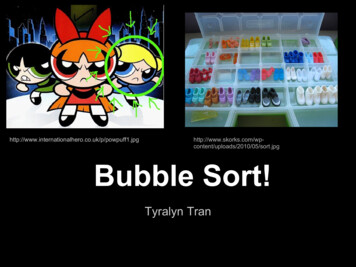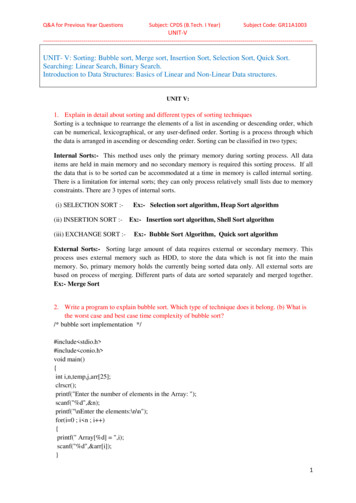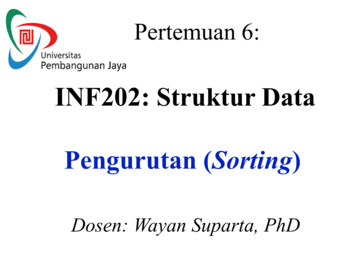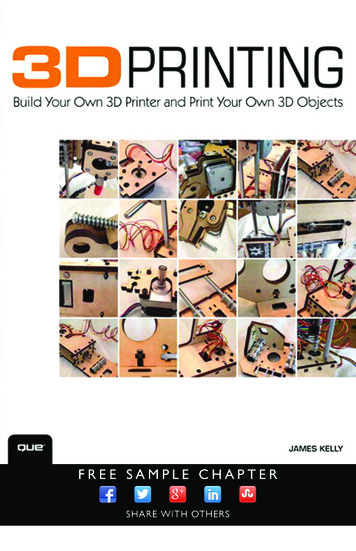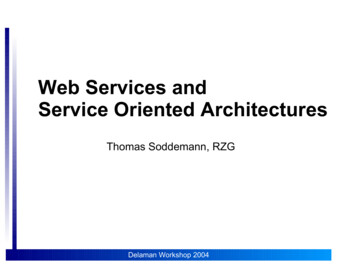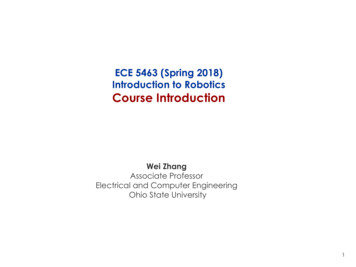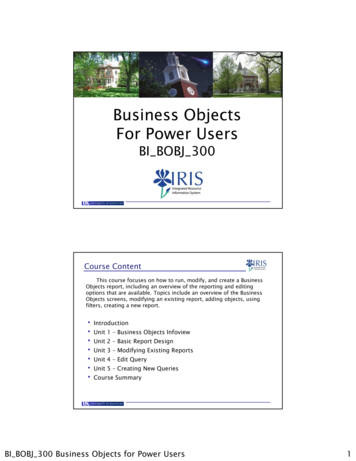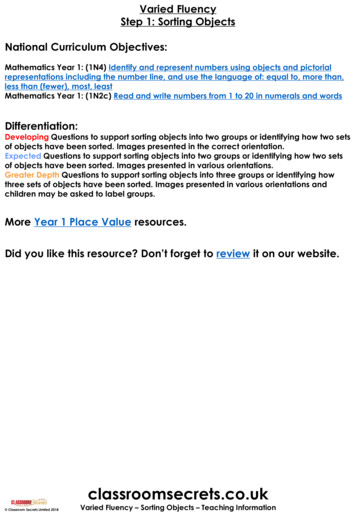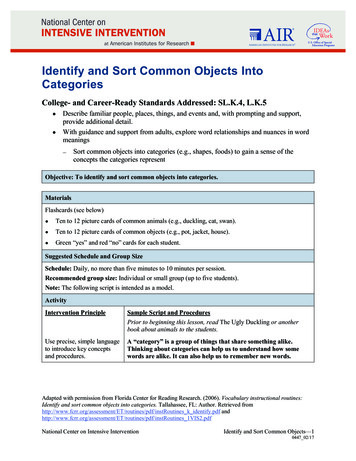
Transcription
Identify and Sort Common Objects IntoCategoriesCollege- and Career-Ready Standards Addressed: SL.K.4, L.K.5Describe familiar people, places, things, and events and, with prompting and support,provide additional detail. With guidance and support from adults, explore word relationships and nuances in wordmeanings ―Sort common objects into categories (e.g., shapes, foods) to gain a sense of theconcepts the categories representObjective: To identify and sort common objects into categories.MaterialsFlashcards (see below) Ten to 12 picture cards of common animals (e.g., duckling, cat, swan). Ten to 12 picture cards of common objects (e.g., pot, jacket, house). Green “yes” and red “no” cards for each student.Suggested Schedule and Group SizeSchedule: Daily, no more than five minutes to 10 minutes per session.Recommended group size: Individual or small group (up to five students).Note: The following script is intended as a model.ActivityIntervention PrincipleSample Script and ProceduresPrior to beginning this lesson, read The Ugly Duckling or anotherbook about animals to the students.Use precise, simple languageto introduce key conceptsand procedures.A “category” is a group of things that share something alike.Thinking about categories can help us to understand how somewords are alike. It can also help us to remember new words.Adapted with permission from Florida Center for Reading Research. (2006). Vocabulary instructional routines:Identify and sort common objects into categories. Tallahassee, FL: Author. Retrieved /instRoutines k identify.pdf instRoutines 1VIS2.pdfNational Center on Intensive InterventionIdentify and Sort Common Objects—10447 02/17
Provide concrete learningopportunities (including useof manipulatives).Today, we are going to sort picture cards into two categories.In the story The Ugly Duckling, we read about some animals.Today, I will sort pictures of things that are animals into the“animal” category and pictures of things that are not animals intothe “not animal” category.Use explicit instruction andmodeling with repetition toteach a concept ordemonstrate steps in aprocess.Show a picture of a duckling. An animal is a living thing thatbreathes and can move around. In the story The Ugly Duckling, theduckling is an animal. The duckling is a living thing that breathesand moves around. I will put the picture of the duckling in thecategory “animal.”Why did I put the picture of the duckling in the ‘animal’ category?Pause for student response.Show a picture of a pot. This is a picture of a pot. A pot is not aliving thing. A pot cannot move around and it cannot breathe. Iwill put the picture of the pot in the category “not animal.” Whydid I put the picture of the post in the “not animal” category?Pause for student response.Provide repeatedopportunities for students topractice and give feedback.Continue showing one or two pictures of animals and one or twopictures of other common objects in random order. Name and sort thepictures into “animal” and “not animal” following the same format.Ask students to explain each categorization.Break tasks into smallersteps compared with lessintensive levels of instructionand intervention.Now we can see all of the pictures that are animals. They look verydifferent, but they have some things alike. They are all living. Theyall can breathe, and they can all move around. Let’s see if you canhelp me sort pictures into two categories, “animal” and “notanimal.”What’s an animal? Pause for student response.I’m going to show you a picture. You’ll respond by holding up thegreen “yes” card if the picture shows an animal. Hold up the red“no” card if the picture is not an animal.Have students explain newconcepts in their own words,incorporating the importantterms you’ve taught.Hold up a picture of a swan. What does this picture show? (Swan.) Isa swan an animal? Hold up your “yes” or “no” card to show yourresponse. Teacher and students hold up “yes” card. That’s correct.How do you know? Pause for student response.Hold up a picture of a cat. What does this picture show? (Cat.) Is acat an animal? Hold up your “yes” or “no” card to show yourresponse. Teacher and students hold up “yes” card. That’s correct.How did you know that a cat is an animal? Pause for studentresponse.National Center on Intensive InterventionIdentify and Sort Common Objects—2
Fade steps from examples sothat students graduallyassume responsibility forcompleting steps. Providefeedback.Hold up a picture of a jacket. What does this picture show? (Ajacket.) Is a jacket an animal? Pause for student response. That’scorrect. How did you know that a jacket is not an animal? Pausefor student response.Continue sorting pictures into “animal” and “not animal” categories,following the same format. Provide practice opportunities for studentsto sort pictures into the categories.Now we’re going to work as partners to sort the pictures. I’m goingto give you and your partner the pictures. You will sort thepictures into two categories: “animal” and “not animal”. What isan animal? (A living thing that breathes and can move around.)That’s correct. Sort all the pictures of living things that breatheand can move around into the “animal” category. If the picture issomething that is not a living thing, put it in the “not animal”category.Monitor student partners as they sort the pictures into two categoriesand provide feedback.Error CorrectionProvide immediate andexplicit error correction.Have the students practicethe correct responses.That’s not quite right. Remember, an animal is a living thing thatcan breathe and move around. This picture shows a mop. I knowthat a mop cannot breathe or move around by itself, so I will put itin the “not animal” category.Have the students demonstrate the correct response before moving tothe next animal or object. If difficulties persist, provide other examplesusing a more basic category (e.g., color).Instructional ConsiderationsOnce students developfluency, move to a moredifficult concept or set ofcategories. Provide ongoingpractice opportunities tofacilitate skill maintenance. Provide frequent group or individual opportunities for students tosort common objects into various categories (e.g., provide smallpictures for sorting into predetermined and labeled categories). Increase the level and number of categories for each sortingactivity (e.g., animals—jungle, farm, ocean). Have students create their own categories to sort given sets ofitems.National Center on Intensive InterventionIdentify and Sort Common Objects—3
Adapted with permission from Florida Center for Reading Research. (2006). Vocabulary instructional routines: Identify and sort common objects intocategories. Tallahassee, FL: Author. Retrieved from tRoutines k identify.pdf instRoutines 1VIS2.pdfNational Center on Intensive InterventionIdentify and Sort Common Objects—4
Adapted with permission from Florida Center for Reading Research. (2006). Vocabulary instructional routines: Identify and sort common objects intocategories. Tallahassee, FL: Author. Retrieved from tRoutines k identify.pdf instRoutines 1VIS2.pdfNational Center on Intensive InterventionIdentify and Sort Common Objects—5
Adapted with permission from Florida Center for Reading Research. (2006). Vocabulary instructional routines: Identify and sort common objects intocategories. Tallahassee, FL: Author. Retrieved from tRoutines k identify.pdf instRoutines 1VIS2.pdfNational Center on Intensive InterventionIdentify and Sort Common Objects—6
Adapted with permission from Florida Center for Reading Research. (2006). Vocabulary instructional routines: Identify and sort common objects intocategories. Tallahassee, FL: Author. Retrieved from tRoutines k identify.pdf instRoutines 1VIS2.pdfNational Center on Intensive InterventionIdentify and Sort Common Objects—7
Adapted with permission from Florida Center for Reading Research. (2006). Vocabulary instructional routines: Identify and sort common objects intocategories. Tallahassee, FL: Author. Retrieved from tRoutines k identify.pdf instRoutines 1VIS2.pdfNational Center on Intensive InterventionIdentify and Sort Common Objects—8
Adapted with permission from Florida Center for Reading Research. (2006). Vocabulary instructional routines: Identify and sort common objects intocategories. Tallahassee, FL: Author. Retrieved from tRoutines k identify.pdf instRoutines 1VIS2.pdfNational Center on Intensive InterventionIdentify and Sort Common Objects—9
YES NOAdapted with permission from Florida Center for Reading Research. (2006). Vocabulary instructional routines: Identify and sort common objects intocategories. Tallahassee, FL: Author. Retrieved from tRoutines k identify.pdf instRoutines 1VIS2.pdfNational Center on Intensive InterventionIdentify and Sort Common Objects—10
With guidance and support from adults, explore word relationships and nuances in word meanings ― Sort common objects into categories (e.g., shapes, foods) to gain a sense of the concepts the categories represent Objective: To identify and sort common objects into categories. Materials Flashcards (see below)
